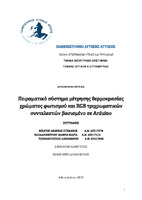| dc.contributor.advisor | Drakopoulos, Panos | |
| dc.contributor.author | Τζουανόπουλος, Αλέξανδρος | |
| dc.contributor.author | Παπαδημητρίου, Ιωάννα Μαρία | |
| dc.contributor.author | Βικάτος, Ανδρέας Στέφανος | |
| dc.date.accessioned | 2023-03-06T07:37:11Z | |
| dc.date.available | 2023-03-06T07:37:11Z | |
| dc.date.issued | 2023-02-22 | |
| dc.identifier.uri | https://polynoe.lib.uniwa.gr/xmlui/handle/11400/3803 | |
| dc.identifier.uri | http://dx.doi.org/10.26265/polynoe-3643 | |
| dc.description.abstract | Σκοπός της παρούσας πτυχιακής είναι η πραγματοποίηση μιας κατασκευής
βασισμένη στο σύστημα Arduino η οποία συνδέεται με έναν αισθητήρα κατάλληλο για
την αναγνώριση χρωμάτων . Η εργασία αποτελείται από το κατασκευαστικό μέρος
που χρειάζεται να γίνει η ένωση των καλωδίων με το ARDUINO, την λάμπα led και τον
αισθητήρα αλλά και από την πραγματοποίηση ενός προγραμματισμού με τον οποίο το
Arduino θα είναι ικανό να διαβάζει και να μας υποδεικνύει τις τιμές που ζητάμε αλλά θα
αναπαράγει επίσης μέσω του LED το κάθε χρώμα που του υποδεικνύουμε. Επιπλέον
μας έχει ζητηθεί να ορίσουμε τις τριχρωματικές τιμές, την θερμοκρασια χρώματος και
την ένταση φωτεινότητας lux στο κάθε χρώμα.
Στο θεωρητικό κομμάτι της εργασίας, ανάλογα με το κεφάλαιο θα αναφερθούμε σε
κάποιες θεωρίες οι οποίες θα βοηθήσουν στην κατανόηση της όλης κατασκευής.
Αυτές είναι η τριχρωματική θεωρία, η θεωρία και ο τύπος του Planck, η ανάλυση της
θεωρίας του φωτός ανάλογα με το μήκος κύματος, τα μήκη κυμάτων των χρωμάτων
αλλά και το μήκος κύματος του ορατού φάσματος. Θα γίνει μια μικρή αναφορά στη
λειτουργία του ανθρώπινου οφθαλμού σε σχέση με το ορατό φάσμα αλλά και στην
αντίληψη των χρωμάτων. Σημαντικό κεφάλαιο είναι η επεξήγηση των χρωμάτων και
την θερμοκρασία τους σε Kelvin, ποιά είναι τα βασικά και πώς από αυτά πως
δημιουργούνται τα δευτερεύοντα, η σημασία του RGB, του sRGB καθώς και γιατί
δημιουργήθηκε η Διεθνής Επιτροπή Φωτισμού. | el |
| dc.format.extent | 64 | el |
| dc.language.iso | el | el |
| dc.publisher | Πανεπιστήμιο Δυτικής Αττικής | el |
| dc.rights | Αναφορά Δημιουργού - Μη Εμπορική Χρήση - Παρόμοια Διανομή 4.0 Διεθνές | * |
| dc.rights | Attribution-NonCommercial-NoDerivatives 4.0 Διεθνές | * |
| dc.rights.uri | http://creativecommons.org/licenses/by-nc-nd/4.0/ | * |
| dc.subject | Arduino | el |
| dc.subject | RGB | el |
| dc.subject | Τριχρωματικές τιμές | el |
| dc.subject | Χρώμα | el |
| dc.subject | Θερμοκρασία | el |
| dc.subject | Φως | el |
| dc.subject | Φωτισμός | el |
| dc.subject | Προγραμματισμός | el |
| dc.subject | CMYK | el |
| dc.subject | Ορατό Φως | el |
| dc.subject | Πειραματατικό σύστημα | el |
| dc.subject | Αισθητήρας χρώματος | el |
| dc.title | Πειραματικό σύστημα μέτρησης θερμοκρασίας χρώματος φωτισμού και RGB τριχρωματικών συντελεστών βασισμένο σε Arduino | el |
| dc.title.alternative | Arduino-based experimental lighting color temperature and RGB trichromatic coefficient measurement system | el |
| dc.type | Πτυχιακή εργασία | el |
| dc.contributor.committee | Drakopoulos, Panos | |
| dc.contributor.committee | Ninos, George | |
| dc.contributor.committee | BARTZIS, VASILEIOS | |
| dc.contributor.faculty | Σχολή Επιστημών Υγείας & Πρόνοιας | el |
| dc.contributor.department | Τμήμα Βιοϊατρικών Επιστημών | el |
| dc.description.abstracttranslated | The purpose of this thesis is the realization of a construction based on the Arduino system
which is connected to a sensor suitable for color recognition. The work consists of the
construction part that needs to be done to connect the wires to the ARDUINO, the LED and
the sensor but also the realization of a programming by which the Arduino will be able to
read and indicate the values we ask but will also reproduce through the LED each color we
indicate. In addition we have been asked to define the trichromatic values, the color
temperature and the lux luminance in each color.
In the theoretical part of the thesis, depending on the chapter, we will refer to some
theories which will help in understanding the whole construction. These are the trichromatic
theory, Planck's theory and formula, the analysis of the theory of light according to
wavelength, the wavelengths of the colours and the wavelength of the visible spectrum. A
brief reference will be made to the function of the human eye in relation to the visible
spectrum and the perception of colours. An important chapter is the explanation of colours
and their temperature in Kelvin, what are the primary colours and how the secondary ones
are created from them, the importance of RGB, sRGB and why the International Commission
on Illumination was created. | el |


